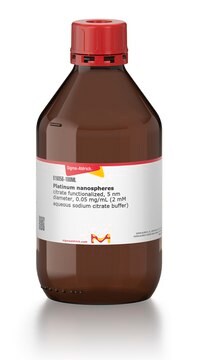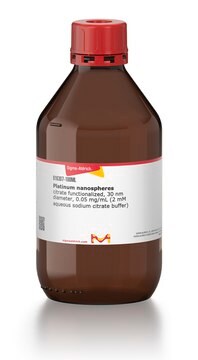773875
Platinum, nanoparticle dispersion
3 nm particle size, 1,000 ppm in H2O, 99.99% trace metals basis
Synonym(e):
Platinum colloid, Pt NP, Pt dispersion
About This Item
Empfohlene Produkte
Qualitätsniveau
Assay
99.99% trace metals basis
Form
dispersion
nanoparticle
Eignung der Reaktion
reagent type: catalyst
core: platinum
Konzentration
1,000 ppm in H2O
Partikelgröße
3 nm
Dichte
0.997 g/mL at 25 °C
InChI
1S/Pt
InChIKey
BASFCYQUMIYNBI-UHFFFAOYSA-N
Anwendung
WGK
nwg
Hier finden Sie alle aktuellen Versionen:
Besitzen Sie dieses Produkt bereits?
In der Dokumentenbibliothek finden Sie die Dokumentation zu den Produkten, die Sie kürzlich erworben haben.
Kunden haben sich ebenfalls angesehen
Artikel
Electronically, it behaves as a wide band gap (3.2 eV) semiconductor and exhibits memristor properties.2 Optically, TiO2 has high opacity with a very high refractive index3 (>2.4), and it exhibits strong absorbance in the UV range.
Nanomaterials are considered a route to the innovations required for large-scale implementation of renewable energy technologies in society to make our life sustainable.
The past several decades have seen major advancements in the synthesis of metal nanomaterials. Most recently, controlled synthesis has become versatile enough to regulate the exact number of atoms and ligands of very small metal nanoparticles, referred to as “clusters”.
Unser Team von Wissenschaftlern verfügt über Erfahrung in allen Forschungsbereichen einschließlich Life Science, Materialwissenschaften, chemischer Synthese, Chromatographie, Analytik und vielen mehr..
Setzen Sie sich mit dem technischen Dienst in Verbindung.





